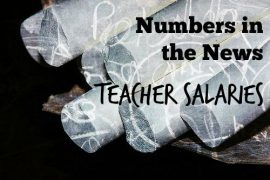Ah, the trend story — we love them and we hate them. Presumably, they tell us what’s hot or not, but they also overgeneralize with very few sources. Ask a room full of writers about trend stories, and you’re likely to see a few eyerolls. Here are some examples:
Male college students seek sugar daddies to pay tuition bills
Female college students seek sugar daddies to pay tuition bills
Rich kids are taking private jets to summer camp
It’s not that these stories are inherently bad. In fact, they’re fascinating. The problem with trend stories is that too many readers, viewers and listeners take them to the next, not-so-logical step. These stories don’t mean that all men wear buns or that even a majority of men in Brooklyn wear buns. What they actually mean is that the reporter discovered a certain number of men in Brooklyn — plus a Top Chef contestent — wearing “man buns.”
That’s because words like majority or most or average actually have mathematical meanings. What’s more, I believe we count on these words to have real meaning, rather than serving as euphemisms for something that the reporter or editor saw a few times. Even using words like many or some isn’t a great way around this. These words cloud issues, rather than elucidate them.
Let’s look at an example. For a few years, sociologists, city planners and reporters have been talking about “food deserts.” These are geographic areas where residents have very few good options for grocery shopping. Because these are poorer regions, people tend to get their food from convenience stores or fast food restaurants, because they can’t drive or take public transportation to shop for fresh fruits and vegetables.
Sounds awful doesn’t it? For a few months, I saw dozens of stories on this phenomenon. But are food deserts ubiquitous? Or were these reports based on a few examples? Thing is, we can actually find out. (Check out the link to see for sure.)
That’s where statistics come in. And reporters don’t necessarily have to do the hard work of crunching these numbers. What is really important is the ability to interpret the data. And it’s critical to know about something called the Law of Large Numbers. [pullquote]The Law of Large Numbers says that the average of the results obtained from a large number of trials should be close to the expected value.[/pullquote]
In probability, performing the same experiment over and over again (and recording the results) is paramount. Otherwise, the data and conclusions just won’t mean much. The Law of Large Numbers says that the average of the results obtained from a large number of trials should be close to the expected value.
Without going into the nitty-gritty of the math, we can use the gist of the Law of Large Numbers to apply to trend stories. If you want to know whether food deserts are a real trend, you’d better locate more than three of them. If you want to say that they’re located in urban areas, you should check rural areas too. Because if your conclusion is based on only a handful of data, it’s not worth much.
And that’s not all. If you only look at data from a set with only certain characteristics, you can’t generalize your conclusion. It might be easy for those of us who live in cities to assume that food deserts are only in urban areas, right? Perhaps this is where trend stories are most likely to fail–when the writer or editor doesn’t consider life outside his personal bubble.
In other words, if you know three female college students who are financing their tuition with the help of “sugar daddies,” that doesn’t mean this is happening all over the U.S. You’d better get some more solid data than that, or you’re not being a responsible journalist.
And for all of you readers out there, look for these signs of a trend story gone awry: most, many, some say, could be, etc. Enjoy the story, if you are so inclined, but don’t make the mistake of generalizing the anecdotes past exactly what has been reported.
In other words, a couple of guys in Brooklyn may be wearing man buns, but that doesn’t mean you (or a guy you know) won’t look out of place in your neck of the woods.
What are your favorite trend stories? Have you ever written a trend story that succeeded? If you’re a writer, what advice do you have for other writers for avoiding the trend-story trap?








Comments are closed.